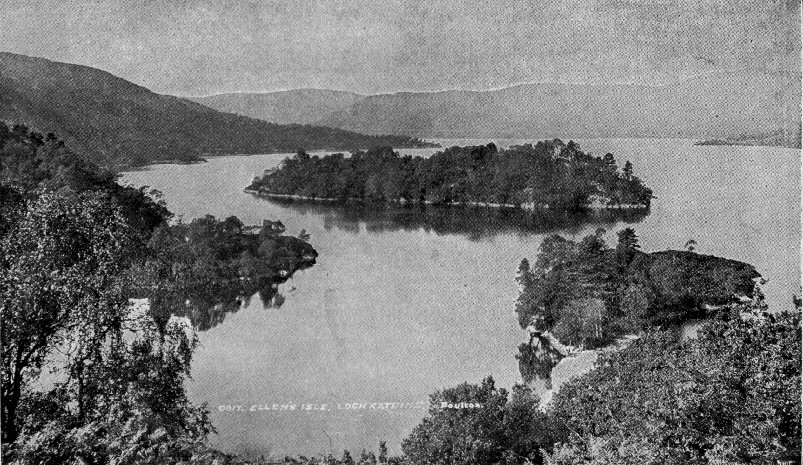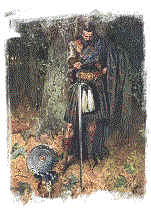![]()
Sir Walter Scott
&
the Clan Gregor
![]()
The Life of Sir Walter Scott
Sir Walter Scott was born in Edinburgh in 1771, - the son of Walter Scott, who belonged to a society of solicitors known as
Writers to the Signet. At the age of eighteen months, he was struck by a
fever, which left him permanently lame. As a result of his delicate health he spent
much of his childhood in the country, returning to school in Edinburgh from time to
time. After leaving the University, he worked for some years in his father's office,
and subsequently studied law.
- the son of Walter Scott, who belonged to a society of solicitors known as
Writers to the Signet. At the age of eighteen months, he was struck by a
fever, which left him permanently lame. As a result of his delicate health he spent
much of his childhood in the country, returning to school in Edinburgh from time to
time. After leaving the University, he worked for some years in his father's office,
and subsequently studied law.
In 1792, he began a study of Border life and customs, and during the following years explored many of the wilder districts of Scotland. In 1797, he married, and after living a short time in Edinburgh, he took up his residence at Lasswade, six miles out of the city, whence he departed in 1804 to a residence known as Asheatiel, on the Tweed. In 1799, he was appointed sheriff of Selkirkshire, an office which gave him an opportunity to indulge his tastes for romantic scenery and legend.
In 1802 he began the publication of a collection of poetry known as 'The Minstrelay of the Scottish Border' and this was followed, in 1805, by the publication of The Lay of the Last Minstrel, the first of his great poetical romances. His success was so encouraging that he gave up the profession of law, entered into a secret partnership with James Ballantyne, a publisher, and resolved to devote himself to literature.
In 1808 Marmion appeared and in 1810 The Lady of the Lake was published. So great was the success of these ventures that in the following year (1811) he purchased the estate of Abbottsford on the Tweed, and proceeded with the erection of a great family residence.
In 1814 Scott's first novel, Waverley, was published anonymously. It was received with such favour by the public that from this time forward Scott devoted himself to prose romance, and during the next sixteen years he continued to produce novel after novel. He published "Rob Roy" in 1818. In 1825, however, the publishing house of Ballantyne failed, and Scott found himself suddenly bankrupt.
With characteristic energy he set out to pay off the obligations of the firm. But his health was unequal to the strain, and in 1830 he was stricken with paralysis. The following year he went to Italy in the hope of restoring his health, but in vain. It was with difficulty that he was able to return to Scotland; and two months after his return he died in September, 1832. He was buried in the abbey at Dryburgh.
Scott owed his great popularity both as a poet and as a novelist to the healthy spirit of outdoor life and adventure which is found in his romances, and to the fact that he was able to combine in his stories various threads of human interest which made his work attractive to all classes of readers.
Neither his poems nor his prose contains profound thought or the discussion of serious problems, but they present a picture-gallery of characters and a vivid description of life and customs in which he remains to this day without a rival.
![]()
The Lady of the Lake

This classic romantic poem is a story about Royal intrigue and the clash of cultures in the highlands of Perthshire (MacGregor country) during the reign of James V (1513-1532). James was one year old when his father was killed in battle at Flodden. James had been confined to Stirling castle under the 'protection' of the Duke of Albany.
His mother, Margaret, the sister of King Henry VIII of England, married Douglas, the Earl of Angus, the most powerful of her nobles. The ensuing power struggle between the Douglas's and John, Duke of Albany, consumed Scotland in intrigue and dissension until Albany left Scotland never to return.
James finally escaped from the Douglas's and set about to secure law and order in his realm. He first crushed the power of the great Border chiefs, after which he turned his attention to the Highlands. Although he tempered lenity with severity, his interferences with the traditional rights of Highland chiefs earned their lasting enmity.
![]()
The Story
Many of the minor details of the story are based upon
incidents with which Scott was familiar. Throughout the poem Scott attempted to give
an accurate account of the customs and manners of the Highland clans of which very little
was known even by educated people in Scotland in his day.
The geographical details
are accurate.
Main characters:
Ellen Douglas; a young maid (the Lady of the Lake)
Fitz-James; King James V (traveling incognito)
Roderick Dhu; Chief of the clan Alpin (Gregor)
Malcom Graeme; Chief of the clan Graham (Ellen's betrothed lover)

Upon learning that the King was coming to invade the
 Highlands and punish the clan Alpin, Roderick summoned the Fiery Cross. According to
tradition, he slew a goat, and making a cross of any light wood, seared it in a fire and
then smeared it with the blood of the goat. This was called the Fiery Cross,
also Crean Tarigh (Cross of Shame), because disobedience to that which the symbol
implied meant, inferred infamy. It was delivered to a swift and trusty messenger,
who ran full speed with it to the next village; and thus it passed with incredible speed
through all the district which owed allegiance to the chief, and also amongst his allies
and neighbours, if the danger was common to them.
Highlands and punish the clan Alpin, Roderick summoned the Fiery Cross. According to
tradition, he slew a goat, and making a cross of any light wood, seared it in a fire and
then smeared it with the blood of the goat. This was called the Fiery Cross,
also Crean Tarigh (Cross of Shame), because disobedience to that which the symbol
implied meant, inferred infamy. It was delivered to a swift and trusty messenger,
who ran full speed with it to the next village; and thus it passed with incredible speed
through all the district which owed allegiance to the chief, and also amongst his allies
and neighbours, if the danger was common to them.
At sight of the cross, every man from sixteen to sixty, capable of bearing arms, was obliged instantly to repair, in his best arms and accoutrements, to the place of rendezvous. He who failed to appear suffered the extremities of fire and sword. During the Jacobite Wars, the fiery cross often made its circuit; and upon one occasion it passed through the whole district of Breadalbane, a tract of thirty-two miles, in three hours.